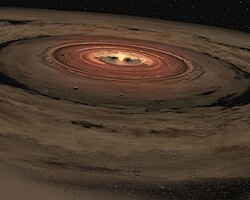OTS 44
| Dữ liệu quan sát Kỷ nguyên J2000.0 Xuân phân J2000.0 | |
|---|---|
| Chòm sao | Yển Diên |
| Xích kinh | 11h 10m 11,5s |
| Xích vĩ | −76° 32′ 13″ |
| Các đặc trưng | |
| Kiểu quang phổ | M9,5[1] |
| Trắc lượng học thiên thể | |
| Khoảng cách | 554 ly (170 pc) |
| Chi tiết | |
| Khối lượng | 0,011[2] M☉ |
| Bán kính | 0,23[1]–0,57[3] R☉ |
| Độ sáng | 0,0013[1]–0,0024[3] L☉ |
| Nhiệt độ | 1,700[2][3]–2,300[1] K |
| Cơ sở dữ liệu tham chiếu | |
| SIMBAD | dữ liệu |
OTS 44 là một thiên thể có khối lượng hành tinh trôi nổi tự do hoặc là một sao lùn nâu nằm ở 550 năm ánh sáng (170 pc) trong chòm sao Yến Diên (tiếng La Tinh: Chamaeleon) gần tinh vân phản xạ IC 2631. Nó nằm trong số các vật thể trôi nổi tự do có khối lượng thấp nhất, với khối lượng xấp xỉ 11,5 lần khối lượng Sao Mộc, hoặc xấp xỉ 1,1% so với Mặt trời.[2][4] Bán kính của nó không được biết đến nhiều và được ước tính là 23-57% so với Mặt trời.[1][3]
OTS 44 được phát hiện vào năm 1998 bởi Oasa, Tamura và Sugitani với tư cách là một thành viên của khu vực hình thành sao Chamaeleon I.[5][6] Dựa trên các quan sát hồng ngoại với Kính viễn vọng Không gian Spitzer và Kính thiên văn không gian Herschel, OTS 44 phát ra một lượng dư bức xạ hồng ngoại cho một vật thể thuộc loại này, cho thấy nó có một đĩa vòng quanh sao gồm các hạt đá và băng.[1][3][7] Đĩa này có khối lượng ít nhất 10 khối lượng Trái Đất.[3] Các quan sát với máy quang phổ SINFONI tại Kính thiên văn rất lớn cho thấy đĩa đang tích tụ vật chất với tốc độ xấp xỉ 10−11 khối lượng của Mặt Trời mỗi năm.[3] Cuối cùng nó có thể phát triển thành một hệ hành tinh.[8]
Xem thêm
[sửa | sửa mã nguồn]- SCR 1845-6357, một hệ sao đôi (hay hệ sao nhị phân) bao gồm sao lùn đỏ và sao lùn nâu.
- Cha 110913-773444, là một vật thể thiên văn được bao bọc bởi một đĩa có thể là đĩa tiền hành tinh.
Tham khảo
[sửa | sửa mã nguồn]- ^ a b c d e f Luhman, K. L.; và đồng nghiệp (tháng 2 năm 2005), “Spitzer Identification of the Least Massive Known Brown Dwarf with a Circumstellar Disk”, The Astrophysical Journal, 620 (1): L51–L54, arXiv:astro-ph/0502100, Bibcode:2005ApJ...620L..51L, doi:10.1086/428613
- ^ a b c Bonnefoy, M.; Chauvin, G.; Lagrange, A.-M.; Rojo, P.; Allard, F.; Pinte, C.; Dumas, C.; Homeier, D. (2014). “A library of near-infrared integral field spectra of young M-L dwarfs”. Astronomy & Astrophysics. 562 (127): A127. arXiv:1306.3709. Bibcode:2014A&A...562A.127B. doi:10.1051/0004-6361/201118270.
- ^ a b c d e f g Joergens, V.; Bonnefoy, M.; Liu, Y.; Bayo, A.; Wolf, S.; Chauvin, G.; Rojo, P. (2013). “OTS 44: Disk and accretion at the planetary border”. Astronomy & Astrophysics. 558 (7): L7. arXiv:1310.1936. Bibcode:2013A&A...558L...7J. doi:10.1051/0004-6361/201322432.
- ^ Luhmann, K. L.; Peterson, D. E.; Megeath, S. T. (2004). “Spectroscopic Confirmation of the Least Massive Known Brown Dwarf in Chamaeleon”. The Astrophysical Journal. 617 (1): 565–568. arXiv:astro-ph/0411445. Bibcode:2004ApJ...617..565L. doi:10.1086/425228.
- ^ Tamura, M.; Itoh, Y.; Oasa, Y.; Nakajima, T. (1998). “Isolated and Companion Young Brown Dwarfs in the Taurus and Chamaeleon Molecular Clouds”. Science. 282 (5391): 1095–7. Bibcode:1998Sci...282.1095T. doi:10.1126/science.282.5391.1095. PMID 9804541.
- ^ Oasa, Y.; Tamura, M.; Sugitani, K. (1999). “A Deep Near-Infrared Survey of the Chamaeleon I Dark Cloud Core”. The Astrophysical Journal. 526 (1): 336–343. Bibcode:1999ApJ...526..336O. doi:10.1086/307964.
- ^ “Blurring the lines between stars and planets: Lonely planets offer clues to star formation”. MPIA Science. tháng 9 năm 2013. Truy cập ngày 1 tháng 9 năm 2014.
- ^ Bayo, Amelia; Joergens, Viki; Liu, Yao; Brauer, Robert; Olofsson, Johan; Arancibia, Javier; Pinilla, Paola; Wolf, Sebastian; Ruge, Jan Philipp; Henning, Thomas; Natta, Antonella (tháng 5 năm 2017). “First Millimeter Detection of the Disk around a Young, Isolated, Planetary-mass Object”. Astrophysical Journal Letters (bằng tiếng Anh). 841 (1): L11. Bibcode:2017ApJ...841L..11B. doi:10.3847/2041-8213/aa7046. hdl:10150/624481. ISSN 0004-637X.
Liên kết ngoài
[sửa | sửa mã nguồn]- Astronomers Discover Beginnings of 'Mini' Solar System (Kính viễn vọng Không gian Spitzer)
- MPIA Science Release 2013-09 - Blurring the lines between stars and planets: Lonely planets offer clues to star formation
| |||||||||||
| Sao |
| ||||||||||
| |||||||||||
| |||||||||||
| |||||||||||
Text is available under the CC BY-SA 4.0 license; additional terms may apply.
Images, videos and audio are available under their respective licenses.

